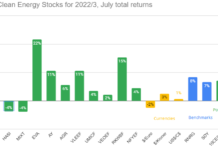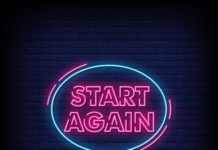Tom Konrad, CFA
The geothermal and demand response stocks in my annual portfolio of ten clean energy stocks for 2011 have fallen significantly since the start of the year, making this an excellent time to buy.
Every year since 2007 I’ve been publishing a list of ten renewable energy and energy efficiency stocks that I think will do well over the coming year. For 2008-10, my list outperformed my clean energy benchmark. This year so far looks like it is going to break my streak, but there is a very bright silver lining: I now think four of my picks are screaming buys.
When considering clean energy stocks, I try to follow a contrarian strategy of focusing on sectors with relatively mature technology and relatively little investor attention. This year, I put particular emphasis on the established smart grid technology, Demand Response, as well as one of the most economical but least talked about forms of renewable electricity, geothermal power. These two sectors are responsible for all of the portfolio’s decline this year, but I still like their prospects, and the reduced stock prices have me buying the demand response companies, and expanding my positions in the geothermal power stocks.
Ten Clean Energy Stocks of 2011
The following table and chart show how each of the picks has performed so far in 2011.
| Company (Ticker) | Sector | % Change 12/31/10 – 3/18/11 | Q1 Dividend |
| Waterfurance Renewable Energy (WFIFF.PK) | Energy Efficiency | 7.4% | 0.9% |
| Comverge (COMV) | Demand Response | -35.6% | |
| EnerNOC (ENOC) | Demand Response | -19.0% | |
| CVTech Group (CVTPF.PK) | Grid/Efficient Vehicles | 9.9% | |
| Telvent Git S.A. (TLVT) | Smart grid/Smart Transport | 9.3% | |
| Potlatch Corp (PCH) | Biomass | 20.1% | 1.6% |
| Nevada Geothermal Power (NGLPF.OB) | Geothermal | -10.5% | |
| Ram Power Corp. (RAMPF.PK) | Geothermal | -34.7% | |
| American Superconductor Corp. (AMSC) | Grid/Wind | -17.5% | |
| Veolia Environnement SA (VE) | Conglomerate | 3.9% | |
| Portfolio return | -6.44% | 0.25% | |
| PowerShares Clean Energy (PBW) | Benchmark | 0.67% | |
| Russell 2000 (^RUT) | Benchmark | 4.46% | |

Demand Response
I’m quite puzzled at the poor performance of demand response companies EnerNOC (ENOC) and Comverge (COMV) so far this year. Demand response companies make money by helping utilities reduce electricity loads through agreements with electricity customers when the utility has trouble meeting demand with available generation capacity.
The news for Demand Response companies has been quite good, with the Federal Energy Regulatory Commission (FERC) recently establishing a landmark ruling which will require utilities to pay demand response companies as much as electricity generators are paid for power capacity. Each market operator must implement this rule by July 22nd, and the resulting tariff changes should open up many new opportunities for demand response companies.
Earlier this quarter, EnerNOC was accused by grid operator PJM of market manipulation, but the case was later dismissed by FERC as having no merit, which is the best outcome EnerNOC could have hoped for.
Both companies had negative earnings surprises for the fourth quarter, with Comverge losing 38 cents compared to the 2 cent lost expected by analysts, but this loss was entirely due to one-time charges, most importantly a goodwill impairment charge.
Regular readers may recall the asset impairment charge that eventually crushed C&D Technologies (CHHPD.PK) last year. The company is now recovering after a massive debt-for equity swap, with some bottom
-fishers sitting on healthy profits of up to 100%, but shareholders who bought early in the year remain far underwater. (I bought too early, but also added to my position at the bottom. Overall, I’m in the red, but not deeply.)
The reason Comverge is not likely to follow the same path as C&D is because Comverge has excellent liquidity, with no net debt and enough cash to fund operating losses and investment for a year or two. EnerNOC is in an even stronger position, being profitable with $6.16 in net cash per share on the balance sheet.
I’ve purchased shares in both Comverge and EnerNOC since the favorable FERC rulings, and have been pleased to be able to do it at lower, rather than higher, prices.
Geothermal Power
The 35% decline in Ram Power Corp. (RAMPF.PK) is partly explained by large cost overruns in the company’s flagship San Jacinto-Tizate project in Nicaragua, and the subsequent resignation of CEO Hezy Ram. The most recent news for the Nicaraguan project has been good, with positive drilling results under a new drilling contractor, and the $20M in extra costs and project delays seem insufficient to account for knocking over $100M off the company’s market cap since the start of the year.
Nevada Geothermal Power (NGLPF.OB) has also seen a decline since the start of the year, but the most significant news was NGP’s purchase of geothermal assets in California’s Imperial Valley from Iceland America. I suspect that the decline arises mostly from sympathy with other geothermal stocks.
I’m still optimistic about geothermal power in 2011. Since the start of the year, I’ve maintained my already large position in Nevada Geothermal, and added to my positions in Ram Power, US Geothermal (HTM), and Magma Energy Corp. (MGMXF.PK). Magma is no longer a pure-play geothermal company, having recently agreed to purchase run-of-river hydro developer Plutonic Power Corp (PUOPF.PK), but run-of-river hydro also conforms to my strategy of focusing on cost-effective renewable energy sectors that have not yet reached the awareness of most investors.
Conclusion
I’ve been frustrated with the high valuations of most clean energy companies for well over a year, so it’s nice to see several of them coming down to prices where I’m comfortable buying. If that means that my annual list of ten clean energy stocks does not beat its industry benchmark this year, I’ll consider it well worth it (with apologies to anyone who bought the list at the start of the year.)
The year is still young, and these stocks seem very cheap to me. Although they’re currently trailing my clean energy benchmark (PBW) by 7%, there are still three quarter to reverse that trend.
DISCLOSURE: Long WFIFF, COMV, ENOC, CVTPF, NGLPF, RAMPF, HTM, MGMXF.
Past performance is not a guarantee or a reliable indicator of future results. This article contains the current opinions of the author and such opinions are subject to change without notice. This article has been distributed for informational purposes only. Forecasts, estimates, and certain information contained herein should not be considered as investment advice or a recommendation of any particular security, strategy or investment product. Information contained herein has been obtained from sources believed to be reliable, but not guaranteed.








Much appreciated update. I earlier bought NGLPF, RAMPF and COMV (at 4.62) and was especially looking for your thoughts on the FERC ruling. I was wondering if there was a good reason that the ruling didn’t help the stock for more than a few hours. Of the stocks I don’t own, I take it you’re more bullish on ENOC than AMSC at current prices. I still am itching to own a transmission/strong grid stock but am learning to wait for the right time.
The reason AMSC is in this list is that I felt I should include a wind play, and I found it in the portfolios of a couple of the better managed clean energy mutual funds. It’s really more of a Chinese wind play than a strong grid play, since that is the source of a majority of its revenues.
I like AMSC’s liquidity and lack of debt, but the consensus is for 2012 earnings to be below 2011 earnings. 2010: $.70; 2011: $1.33; 2012: $1.26. If you believe the 5 year forecast growth of 35%, current valuations are good, but if you’re skeptical about long term growth (will the Chinese keep buying from AMSC or will they shift to home grown technology) the price seems steep. I don’t know which scenario is more likely.
Re geothermal: are you worried about the consistent increase in drilling costs (and time)?
Re Waterfurnace: The company had the federal government pay 30% of the costs of its product and sales were only up 7.1% for the year.
Do you think that implies that there is too much supply out there?
If so, what happens when the stimulus money runs out?
Aram,
Increasing price for geothermal drilling is likely to be a problem for the next few years due to a shortage caused as geothermal cos rush to meet the deadline for the ITC. However, the companies are so cheap right now, a lot can go wrong and they’ll still be decent values.
Re Waterfurnace, the main barriers to the adoption of geothermal heat pumps (as with most energy efficiency technologies) are non-financial. Demand for GHPs is inelastic because people who understand them and who have a property where they can be installed realize that they are a great financial deal with out without a 30% subsidy. The upside of this is that when the subsidy goes away, we won’t see the demand fall much, either.
An example of why the federal subsidy is not very effective is the house I rent. The heat is oil (very expensive), it’s on a good size chunk of land (easy to install a relatively cheap horizontal heat field), but there’s no chance of me getting a GHP- the owner is an estate, and they aren’t interested in investing anything in the property, 30% tax credit or no.
The Federal Energy Regulatory Commission (FERC) ruling would actually require utilities to pay demand response companies more than the price electricity generators are paid for their power capacity. The FERC should not pay demand response companies the full market price for a electricity they did not purchase. Would you allow a company to under contract to purchase 1000 lbs of copper to sell the copper at the current market price for copper of $2/lbs before they actually took delivery and purchased the copper? Clearly not. No economist would think that this send the correct price signal. As a result, I would expect utilities to appeal the unjust FERC ruling.
On paper, I’ve lost nearly half of my investment in Ram Power. I’m inclined to hold on but I need someone to tell me if I’m being foolish. The news I can find is hard for me to interpret but others clearly see reason to sell even now. Is there reason for this slide to continue given the balance sheet? Perhaps I can sell now and buy back when the stock reaches 25 cents.
-David